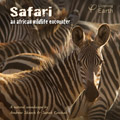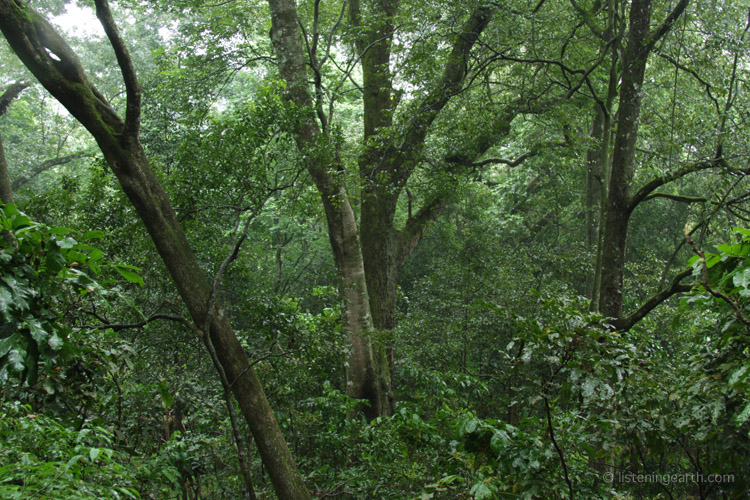

Running Time:
118 min
Release Date:
September 2014
Recording Location:
Mount Meru, Arusha National Park, Tanzania
If you like this album,
we also recommend:
Equatorial Africa - The Forests of Arusha
The bulk of volcanic Mount Meru dominates the Arusha landscape in equatorial East Africa. Looking out from its forested slopes toward the east, its sister volcano, Mt. Kilimanjaro, can be seen on the horizon some 70km distant.
This recording begins in silence under a canopy of tropical forest in the hours before dawn. From far away comes a barely audible murmuring; the huffing of distant colobus monkeys. Like a mexican wave, the sound grows closer, with each successive troupe around the base of the mountain waking the next, until a family of monkeys in the trees overhead begin calling; a wonderful, gruff, barking chorus.
Then it falls silent again. Bush babies call occasionally in the darkness. Soon the dawn birdsong begins, the air becoming filled with the sounds of greenbuls, flycatchers, sunbirds, and groups of colourful turacos which vocalise loudly as they scurry along high branches. Silverey-cheeked hornbills wing overhead, and diurnal cicadas begin buzzing. Birds move around the forest, as do the colobus monkeys, now active and clambering noisily around the treetops.
By late afternoon, other birds are heard, including the dusk singing of an olive thrush. The colobus give their evening chorus and the forest moves imperceptibly into the night.
Andrew comments:
This is an extended recording, nearly two hours in duration. The morning sequence is presented unedited, exactly as it happened.
Our camp at Mt. Meru was in a small forest clearing, a short distance from open areas frequented by large animals. By day, troupes of baboons cavorted and played around our tent. Each night, the parks service provided an armed guard, who slumbered oblivious in our secure kitchen building while we slept in the open. By darkness, our grassy clearing was visited by giraffe, zebra and antelope, and on one occasion we awoke to find a massive buffalo grazing a few metres away. Much of my recording was done in the pitch dark, setting up microphones in the depth of the forest, whilst cautiously scanning for eye-shine from a leopard.
The sounds of colobus monkeys were the highlight - their songs are so gloriously full of life. It was the first time we'd heard them, and we listened spellbound that first afternoon as the forest around us resounded with their voices. Anticipating a morning chorus to counterpoint their afternoon calling, I had the microphones ready the next dawn, and captured the recording presented here.
Audio sample of this album
|
1. |
The Predawn Colobus Monkey Chorus |
16.26 |
|
2. |
Arusha Dawn, with Hartlaub's Turacos and Mountain Greenbuls |
31.51 |
|
3. |
Morning Birdsong on the Slopes of Mt. Meru |
35.31 |
|
4. |
Late Afternoon, and the Colobus Dusk Chorus |
20.33 |
|
5. |
Into the Evening |
13.21 |
Purchase this
album as:
Digital Album
(for immediate download)
Download this album
for as little as
$7.50 -
View Special Deals
(Prices AU$, exGST)
Mp3:
Mp3 is a universal audio format, playable on iPods, computers, media players and mobile phones.
Mp3 is a compressed format, allowing smaller filesizes, offering faster download times and requiring less storage space on players, but at some expense to the audio quality. Many listeners can't really hear the difference between mp3 and full CD-quality audio, and hence its convenience has lead to it becoming the default option for audio.
Our albums are generally encoded at around 256kbps (sometimes with VBR), balancing optimal audio quality without blowing out filesizes excessively. We encode using the Fraunhoffer algorithm, which preserves more detail in the human audible range than the lame encoder.
Our mp3 files are free of any DRM (digital rights management), so you can transfer them to any of your media technology. You've paid for them, they're yours for your personal use without restriction.
Mp3 files can be burned to disc, either as an mp3 disc, or an audio CD after converting them to a standard audio (.wav or .aif) format first.
FLAC:
FLAC is a high-quality audio format, allowing CD-resolution audio. It is ideal if you wish to burn your files to a CDR, or listen over a high resolution audio system. However files usually require special decoding by the user before playing or burning to disc.
FLAC (Free Lossless Audio Codec) is a LOSSLESS compressed audio format. This means that it preserves the full audio quality of a CD, but optimises the filesize for downloading. Typically, file sizes of around 60% are achieved without any degradation or loss of audio quality from the source files at the CD standard of 16bit/44.1kHz.
Obviously the file sizes are larger than for the mp3 version - usually around 300-400Mb for an album, compared to 100Mb for an mp3 album.
In addition, you'll need to know what to do with the files once you've downloaded them. In most cases you'll want to decode the files to wav or aiff, either to import into programs like iTunes, or burn to CDR. Some programs will play flac files natively.
There is a lot of information about flac online (eg: http://flac.sourceforge.net/)




 Alternate audio link
Alternate audio link 